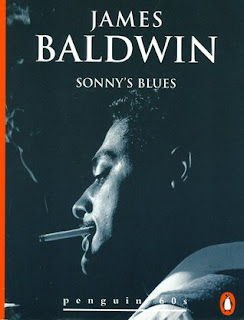Sonny’s Blues Analysis
Sonny’s Blues Analysis
Baldwin’s short story, Sonny’s
Blues, is masterful piece of literature that explores addiction and the ties
that bind our familial obligations. To truly appreciate this composition, one
must first delve into the historical context of the times. When this was
written African Americans were still suffering from Jim Crow Laws. America was
deeply divided and segregated, and many African Americans lived in poverty. The
story takes place in Harlem which at the time was the cultural hub for African
Americans. Harlem also faced a decline
and was home to many housing projects that were homes to the poverty-stricken
community.
Sonny’s brother, who remains
nameless through out the story, is the narrator of the short story. I believe
Baldwin’s omission of his name is intentional. This allows for the focus to be
placed on the main subject of the story, which is the narrator’s little
brother, Sonny. Sonny’s Blues was a beautiful story about a man’s journey of
self-reflection and learning about his brother’s addiction. As with many eldest
siblings, the narrator felt an obligation to look out for his younger brother.
The obligation was also solidified by his mother’s request, (pg. 300) “You got
to hold on to your brother,” she said. “and don’t let him fall, no matter what
it looks like is happening to him and no matter how evil you get with him. You
going to be evil with him many a time. But don’t you forget what I told you,
you hear?” Throughout the story you see that the relationship between the two
siblings is strained. There is a seven-year generational gap, a different taste
in musical predilections, and also status. The narrator at the time is settled
with a job, wife, and children. Sonny on the other hand is neither of those
things and is struggling to find his place in the world as well as within his
passion for jazz music.
The story resonated with me as a former addict.
Sonny’s struggle with addiction was told so eloquently. Sonny’s Blues (pg. 308), “While I was
downstairs before, on my way here, listening to that woman sing, it struck me
all of a sudden how much suffering she must have had to go through – to sing
like that. It’s repulsive to that you have to suffer that much.” Experience is
subjective and carries with it the criteria of using personal knowledge. My
personal knowledge of addiction allows me to view this story with a different
lens. In the beginning of the story, (pg. 293) we catch a glimpse of how the
narrator truly feels toward those who struggle with addiction, “But now,
abruptly, I hated him. I couldn’t stand the way he looked at me, partly like a
dog, partly like a cunning child. I wanted to ask him what the hell he was
doing in the school courtyard.” With this statement, one can sense his anger
and resentment. One can sense the narrator’s false prediction of the immediate
usurping of truth, happiness, and health. Interpretation uses four related
intellectual acts: observing, connecting, inferring, and concluding. As one
interprets Baldwin’s work, one can observe the disconnect between the two
brothers. One can infer that the disconnect that the age gap may have been a
reason for the emotional distance between the brothers. One may also infer the
guilt that Sonny’s brother has for not watching over him more. His mother had
requested that he look out for his younger brother. We also conclude that
having seen Sonny perform in his musical element, Sonny’s brother has a better
understanding of his struggle and how music plays are part in his recovery (pg.
310) “Here, it was not even a question that his veins bore royal blood.”
Lastly, as the evaluation of Sonny’s Blues continues, one can judge the quality
of work based on how effective the story telling was and how engaged the
audience is with it. The reader’s values and morals come into play upon
evaluation as well. Evaluation may change over time as perceptions of life
change.
The truth of suffering amongst addicts is never
looked upon with empathy. How Baldwin infuses music as redemption yet pivots
the description as music being another drug was unparalleled. Addicts tend to
trade one vice for another. Music symbolized many things in Baldwin’s story.
For Sonny, music was a form of escape from the life of an addict. Sonny’s
passion for music is evidenced by Sonny playing on the piano for hours on end,
(pg. 304) “Neither did they dare to make a great scene about that piano because
even they dimly sensed, as I sensed, from so many thousands of miles away, that
Sonny was at that piano playing for his life.” Baldwin also conveyed music as a
rite of passage, a way of finding oneself, (pg. 312) “Creole wasn’t trying any
longer to get Sonny in the water. He was wishing him Godspeed. Then he stepped
back, very slowly, filling the air with immense suggestion that Sonny speak for
himself.”
Sonny’s openness to attempt to explain his
addiction exemplified a truth and vulnerability that is often overlooked when
addicts relapse, (pg 307) “her voice reminded me for a minute of what heroin feels like sometimes – when it’s in
your veins. It makes you feel sort of warm and cool at the same time. And
distant. And – and sure.” The dialogue between the two brothers is pivotal in
the storyline as the reader is able to understand Sonny’s point of view
firsthand. Since the story is then narrated by Sonny’s brother, we also get the
narrators innermost thought to Sonny’s interaction. Even though dialogue is
used sparingly in this story, the reader is still able to glean information
from the characters and the narrator’s point of view.



Comments
Post a Comment